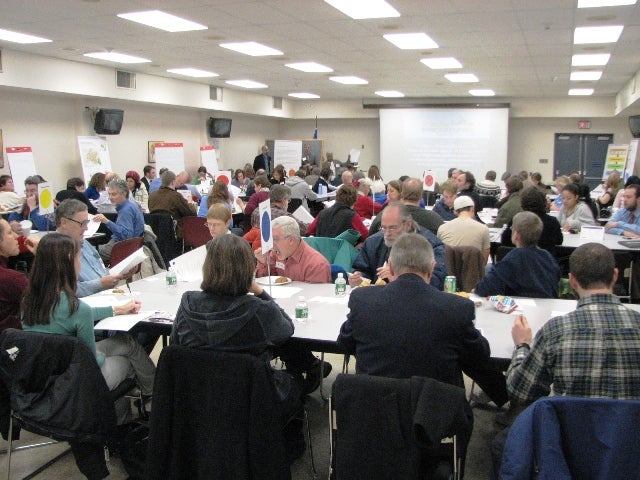Imagine Philadelphia forums conclude

Feb. 1
By Alan Jaffe
For PlanPhilly
The last of nine meetings that asked different neighborhoods to come up with big ideas that would transform the city was held Thursday night in Roxborough. And rather than lose steam, the City Planning Commission’s series of Imagine Philadelphia sessions concluded with a burst of public energy and enthusiasm.
About 110 residents — one of the biggest turnouts since the series began — filled the Wolcoff Auditorium of Roxborough Memorial Hospital on Ridge Avenue on Thursday evening. Earlier meetings sometimes drew no more than 20 people to the discussions. The session held in Germantown last Tuesday, however, attracted 150 participants, including Mayor Nutter, who stopped by to offer his support for the Planning Commission effort.
Imagine Philadelphia is a process that will conclude with the creation of the city’s first comprehensive plan since 1960. Plans addressing specific programs, such as commercial development or greening the urban environment, have been developed or are currently being drawn. But a citywide strategy to attack a multitude of municipal issues has been a long time coming, and the new plan will address the next 20 years of growth and development.
Imagine Philadelphia: Laying the Foundation, the first phase of the process, began in the summer with PCPC meetings with stakeholders on a variety of issues, explained Alan Urek, director of the commission’s strategic planning and policy division. In the fall, the meetings shifted to the communities, with residents discussing eight topics: regionalism, open space and environment, economy, neighborhoods, public services and utilities, housing, transportation, and culture and tourism.
Whether the meetings were held in South, North, West or Northeast Philadelphia, certain currents and concerns ran through all the gatherings: the need for better schools, safer neighborhoods, cleaner streets, more mass transit, more jobs, an equitable tax system, and a responsible, responsive government.
The city’s strengths also emerged in meeting after meeting: its historic and cultural resources, its architectural and natural beauty, and its diverse and proud neighborhoods.
The good and the bad, and the possibilities to be better, arose again at the ninth session.
In a small-group discussion of housing issues, Jim Gleason, a resident of Chestnut Hill, was a champion of rowhouse living.
“The rowhome has gotten a bad rap. It should be seen as a revolutionary form of housing” that uses far less energy than suburban tract developments. “This is the way to deal with global warming,” he said.
“We should promote Philadelphia as a city of rowhouses.”
Gleason also boasted that Northwest Philadelphia has the best neighborhoods in the city for their combination of recreational, residential and commercial resources.
Kathy Detwiler, of Mt. Airy, said the entire city offers “fantastic opportunities to do anything.” But she said Philadelphia should develop agricultural sections within the city for “sustainable food options.”
Greener, small-scale approaches were supported by many participants in the discussion. Tom Landsman, of the Shawmont neighborhood off Ridge Avenue, praised the city’s walkable communities.
But Landsman said such neighborhoods were threatened by developers who don’t recognize the impact they have on surrounding buildings and residents. “Developments should match the character of the existing area. They have to consider the big picture, and how what happens on one block affects the next block,” he said. “The criteria should be, will the effect be better or worse?”
Jo Ann Desper, of Wissahickon, agreed that developers need to perform more “impact analysis. Every change impacts the things around it.” There needs to be “regional planning” rather than case-by-case consideration that originates with the developer’s proposals, she said.
To control development, Landsman said, the city must practice strong zoning code enforcement. “There is none now. And the burden of enforcement falls on individuals.”
Liz Gabor, a real estate manager who lives in Manayunk, said the city also needs to end the practice of spot zoning and using amendments to the code in order to approve contested development.
“The city’s biggest problem,” Gleason said, “is the approach that any development is better than none.”
The group also called for green housing initiatives. Landsman suggested tax credits for installing solar panels and other retrofitting of existing homes.
Gleason stressed the need for storm water recovery efforts, including the distribution of rain barrels. While the suburbs cope with water shortages and parking lot runoff, urban residents have many green solutions, he said.
“City living is the most environmentally friendly way,” he repeated. “We need to tout that.”
At the conclusion of the meeting, Gary Jastrzab, acting executive director of the Planning Commission, said “rowhouse manuals” that address issues raised by the residents would be published shortly by the city.
The next step in the Imagine Philadelphia process, he said, will be “to take the information gathered at these sessions, digest it, and issue a report” that will be posted on the website, www.imaginephiladelphia.com. The input from the nine neighborhood meetings will be combined with the Planning Commission’s research, and a series of white papers on the eight topics will be created. By late summer or early fall, the city planners will return to the neighborhoods to present their findings.
WHYY is your source for fact-based, in-depth journalism and information. As a nonprofit organization, we rely on financial support from readers like you. Please give today.



